Category Archives: All UkulelePlay! Blog Posts
The Song Release Cycle Part 1 : Audio
What goes into releasing a music single? It’s easy enough to do a quick video capture of a song you love to sing with ukulele and post it on YouTube or Facebook, but what do you need to do to release a song that will be available on iTunes, Amazon, Spotify, etc.. More importantly, what can you do to see that the song has a small chance of getting downloaded amid the millions of other selections out there?
These are questions I’m still answering for myself, as I have a goal to release more ‘produced’ singles. Though I’m fairly comfortable with live performance and quick video captures that don’t involve multitracking, I’d like to produce ‘fuller arrangements’ that use some or my other instrumental skills along with my ukulele and voice. However, I keep getting bogged down in the process, stuck in a perpetual loop of rehearsing songs I plan to record (always next week). If this sounds familiar, keep reading.
I sat down last night for a couple of hours and thought about what’s holding me back and how I can streamline the process of producing and releasing a single with an accompanying music video (something that seems essential to me in today’s visually oriented society). Here is a flowchart I put together this morning that outlines the process of working through releasing a single:
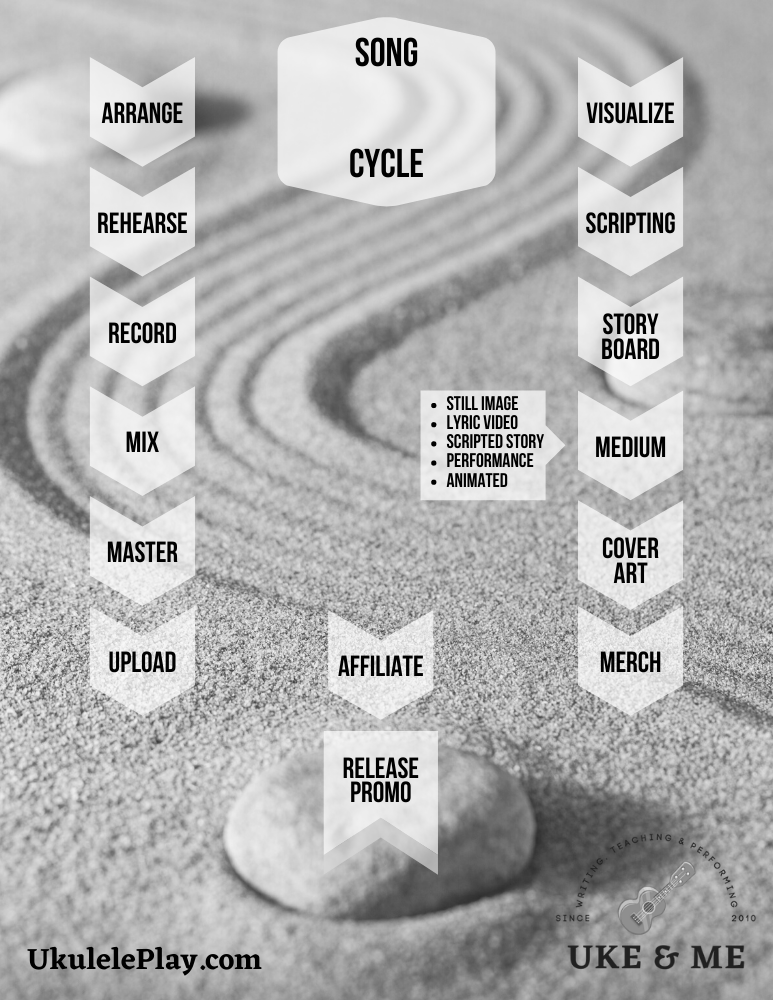
I’ve left a blank spot at the top to put in the name of the song you’re working on. From there it divides into two categories, the audio and the visual. Let’s talk about the audio first.
Audio Workflow
- Choose a song or write a fresh one.
- Arrange: If you’re just arranging for ukulele and voice (or an ukulele instrumental), you’ll still need to commit to what strums, fingerpicking, licks, tabs and leads you want to include in your song. If you want to add bass, percussion, keys or a separate lead instrument (pennywhistle, trumpet, flute: whatever you or your friends play), this is the time to write it out (let’s set improvisation aside for this discussion).
- Rehearse: Now that you know what you want to add to the song, it is time to rehearse all the individual parts (or get other players to rehearse them if you’re collaborating).
- Record: Once you feel really comfy with your arrangement, it is time to start recording. Recording freaks me out. One of the problems that has set up blockages for me is the process of setting and monitoring levels. My voice has a very wide dynamic range (meaning I can sing very soft and very loud). I can’t tell you how many recordings I’ve ruined by just singing a little TOO loud (which causes digital clipping … a less than pleasant noise that renders tracks useless). Finally, I bought a Zoom F6 field recorder with 32-bit float point recording with which setting levels and digital clipping are now a thing of the past (thank Heaven!). I’m now able to record without worrying I’m going to ruin a take by not constantly monitoring my levels and just concentrate on making music.
- Mix: After recording all the individual parts (with a metronome or click track) it is time to upload your tracks into a DAW and mix (I’m a long-time user of Sonar, which is now free for you to use!). I’m fine with mixing, if I can just get over the recording hurdle it is all downhill from here. Mixing usually involves getting the levels balanced, making sure the vocal is not buried, panning tracks, and maybe adding a little EQ here and there. This is also the chance to add reverb or other effects.
- Master: This is the final EQ and sweet spot massaging that the mixed recording gets. I’m not a mastering guru. Thankfully, there are quite a few options out there on Fiverr (many which include mixing), as well as automated services that aren’t too expensive. It’s good to know your limitations and hire out when you need to.
- Upload: Once you’ve got your mastered track it is time to upload it to a distribution service, which will send your track out to the world. Amuse has a great breakdown of music distro services out there. NOTE: To upload your track, you are going to need your cover art ready to go.
Tune in next time for a breakdown of the visual component of music distribution and why it is a good idea to add visuals.
Ukulele Camps & Happenings in June for Utah County
Fun, new ukulele summer camps, based on 10+ years of experience teaching new ukulele players, are coming this June. These updated camps have new music, updated materials and streamlined flow. Beginner camps will get you a smart start on the ukulele or be a great review for anyone who needs a refresh. Advancing camps and Happy Valley Ukes will help take your playing to the next level in a fun, social atmosphere.
- Ukulele at the SCERA in OREM is offering 3 camps in June, two 4-day UKULELE KIDS CAMPS (levels 1 & 2) and UKULELE BOOTCAMP 3.0 for Adults and Teens.
- The Arts Center in American Fork will be concurrently offering two 5-day UKULELE KIDS CAMPS, with a beginner section and an advancing section for return students (or students who already know their basics).
- HAPPY VALLEY UKES, for teens and adults, will begin meeting on Wednesday evenings in June, stay tuned for upcoming details!
Be sure to register early for the camps, as they often sell out.
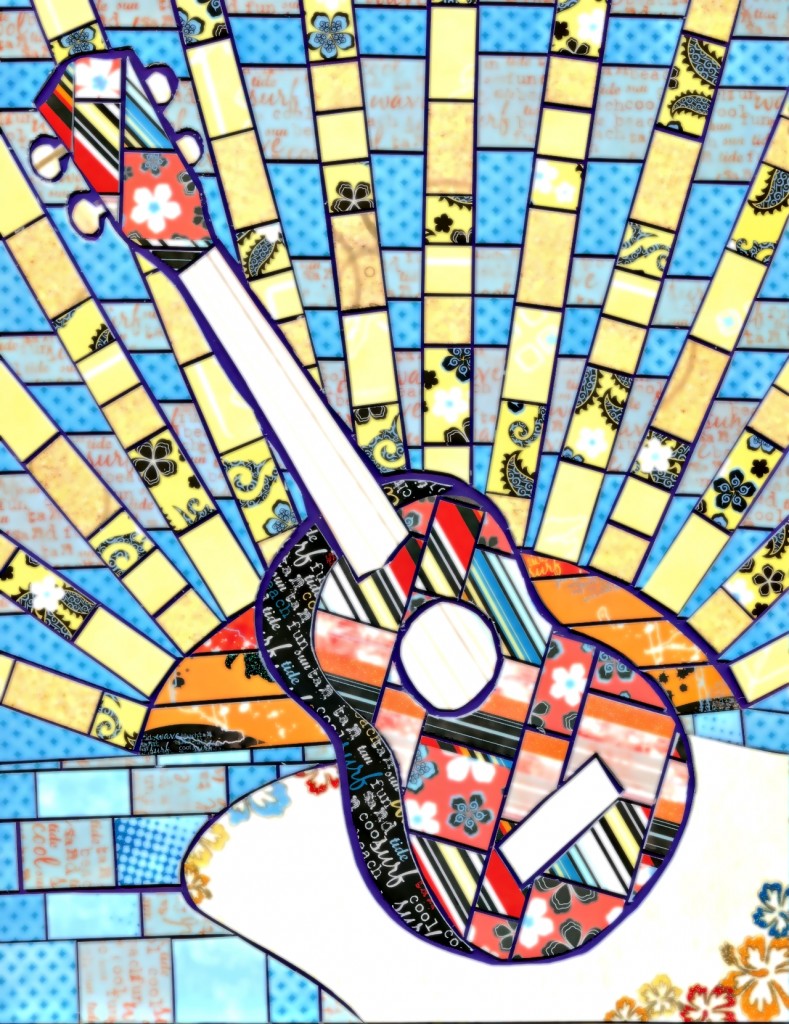
Ukulele Kids Club donates 10,000 Ukulele to sweet little Girl at the Hospital
You can find out more about the Ukulele Kids Club on Facebook or go to their site to make a donation.
“My new ukulele won’t stay in tune. Is there something wrong with the tuners?”
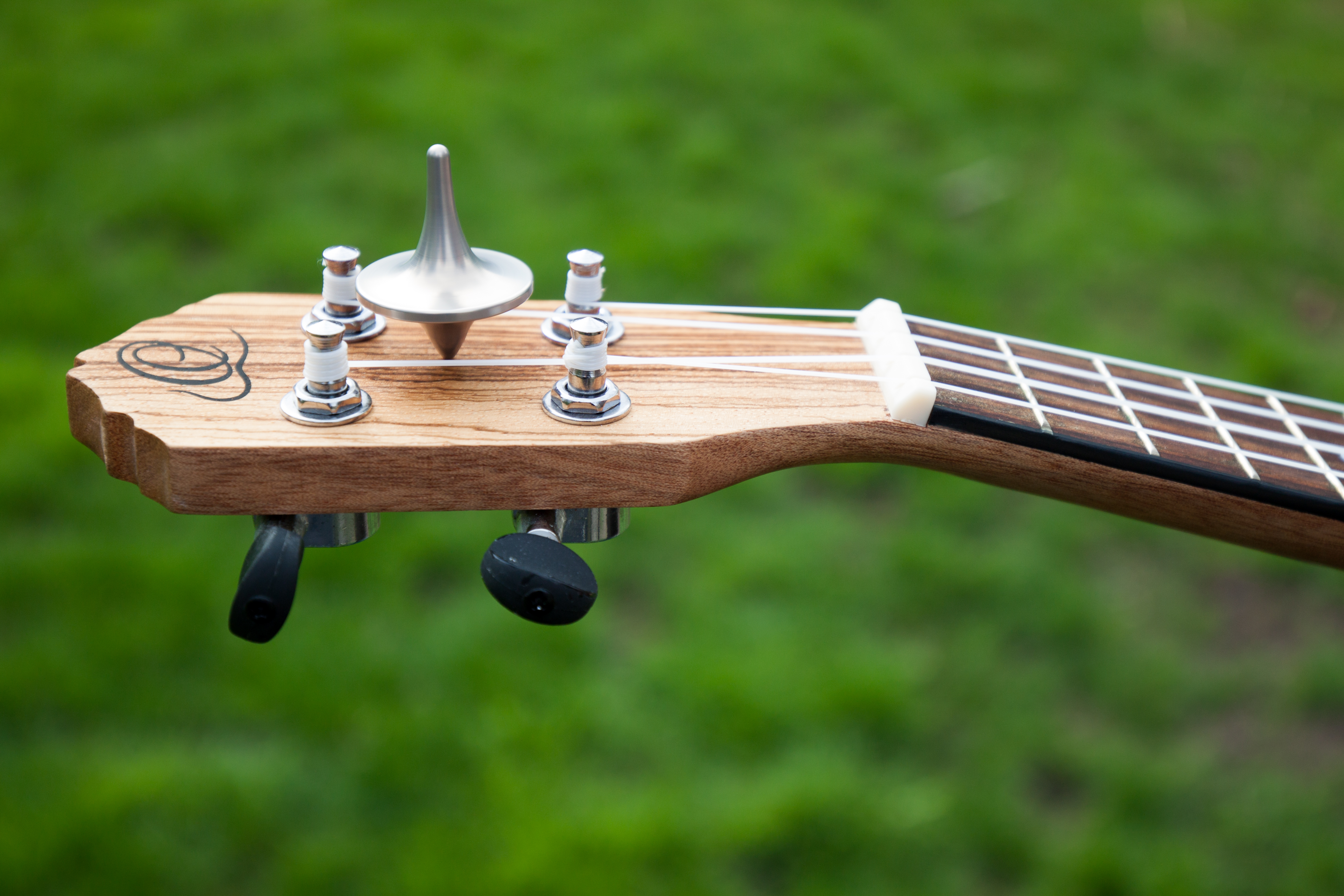
I’ve heard variations of this many times, usually from new players. Today, I read from a new banjolele player who thought it might the drum head (no, it isn’t the drum head). People just don’t realize how stretchy new strings are when they first start out and this is a big source of frustration for some.
An Overnight Fix to Get Your Uke in Tune Quickly
New strings usually take constant tuning until they ‘settle in’ – this can take anywhere from days to weeks. One trick that has worked for me to speed up this process is to tune the ukulele up a whole step higher – ADF#B (which is a standard tuning in some places, so I’m not worried the tension is going to ruin my ukulele); I then let it rest overnight and retune to GCEA the following day.
There are other tricks, which involve stretching the strings with your fingers, but I’ve heard this can cause the strings to stretch unevenly, which could lead to other problems down the road. Although, I don’t have experience with this happening, I stopped recommending this kind of string stretching because it does seem plausible.
So, if you can wait 24 hours, the overnight ADF#B fix described above has been a solid way to cut down on weeks of frustration for me when I install new strings or buy a new ukulele (which probably happens a little too often).
Glendale Utah Ukulele Club Greets the First Lady with 21 Pilots Cover
This week in Utah the First Lady was serenaded by an awesome group of middle school ukulele players. There’s a interview with the teacher prior to the performance that was great to listen to and some video of the “House of Gold” cover on KSL News. Simply delightful.
Top 20 Songs for Ukulele Beginners
51 ukulele players from all over the world responded to a recent survey on best songs for beginners to learn on their first day. There were 44 songs presented in the survey. The criteria for this list included broad familiarity and having 2-3 easy chords (though a couple with 4 might have slipped in). The songs were also filtered by 10 years of experience teaching first day ukulele players in my Ukulele Bootcamps. The results of which songs were chosen of these by surveyors is half expected and half surprising. Some songs I thought would be great, were lemons. Some songs I couldn’t have guessed at how popular they were. Here are results:
20 Ain’t That a Shame (Fats Domino)
19 When the Saints Go Marching In (Spiritual)
18 Rock Around the Clock (Bill Haley & His Comets)
17 Splish Splash (Bobby Darin)
16 Simple Gifts (Folk Spiritual)
15 I Still Haven’t Found What I’m Looking For (U2)
14 This Land is Your Land (Woodie Guthrie)
13 Ghost Riders in the Sky (Johnny Cash)
12 Sugar, Sugar (The Archies)
11 Swing Low, Sweet Chariot (Spiritual)
10 Old Time Rock & Roll (Bob Seger)
9 Day-O, i.e. the Banana Boat Song (Harry Belafonte)
8 Surfin’ USA (The Beach Boys)
7 Ode to Joy (Classical Instrumental)
6 Blowin’ in the Wind (Bob Dylan)
5 Leaving on a Jet Plane (John Denver)
4 You Are My Sunshine (Johnny Cash Version)
THE TOP THREE
3 Singin’ in the Rain (Gene Kelly)
2 Twist and Shout (The Beatles)
1 Feelin’ Groovy (Simon & Garfunkel)
I love Feelin’ Groovy, and have since I was in High School when I bought a cassette tape of the best of Simon and Garfunkel. I was surprised though that it came in as peoples number one favorite. Twist and Shout made more sense to me as it is so upbeat. Again, I love Singin’ in the Rain, but another surprise to me to see how popular it is with others.
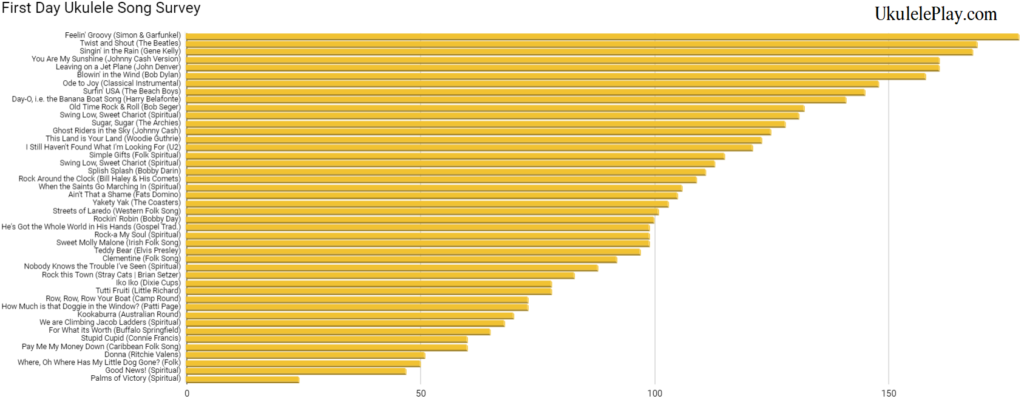
Other Suggestions
I did get a few other great suggestions that weren’t included in the original survey.
- El Condor Pasa (4 chords)
- Riptide (4 chords)
- White Sandy Beach (3 chords)
Though 4 chords on the first day is probably not going to work well in a quick bootcamp, in the following weeks it is entirely possible.
There you go! I hope you find this useful! And here are some more Uke Dogs:

If it were your first day playing ukulele, what songs would you want to learn?
I’m working on my Ukulele Bootcamp 3.0 that I will be teaching in June to new ukulele students. I’ve come up with a big list of possible songs that I think would be great for first time players (2-3 chord songs that are familiar or easy to learn quickly). I’d love to hear what you think! Which of these songs would you most be excited to learn? See bit.ly/ukulelesongsurvey to take the survey.
After submitting, you’ll have the option to see the results of the survey, from those that have taken it so far.
By the by, here are some Uke Dogs …

May Music for Happy Valley Ukes
These are the songs Happy Valley Ukes and supporters on Patreon.com/Uke will be working on in May 2021.
- Good Day Sunshine (The Beatles) – Introduced at the May 8th session
- My Girl (The Temptations) – Introduced at the May 8th session
- Here Comes the Sun (The Beatles) – Introduced at the May 22nd session
- The Tide is High (Blondie) – Introduced at the May 22nd session
Good Day Sunshine and My Girl are the same as the versions found in The Daily Ukulele by Liz & Jim Beloff, so if you already have that, or want to get 365 songs at a great price, look there for those.
Next Happy Valley Ukes Meetups are at the pavilion across the street from the Mt. Timpanogos Temple in Quail Cove Park; the NW corner of 700 N & 900 E in American Fork, UT. ALL members will now meet at 9:30am.
These meetings will be recorded for all members and patrons and posted at Patreon.com/Uke before the following Tuesday.
See this post for more details about live rehearsals.
Cue Cards: What a Wonderful World
My personal cue card, reduced to essentials, from the sheet music of What a Wonderful World. This is one of the songs I’m doing with Happy Valley Ukes in April 2021. You can read about cue cards here. See below the image for additional info on this cue card.
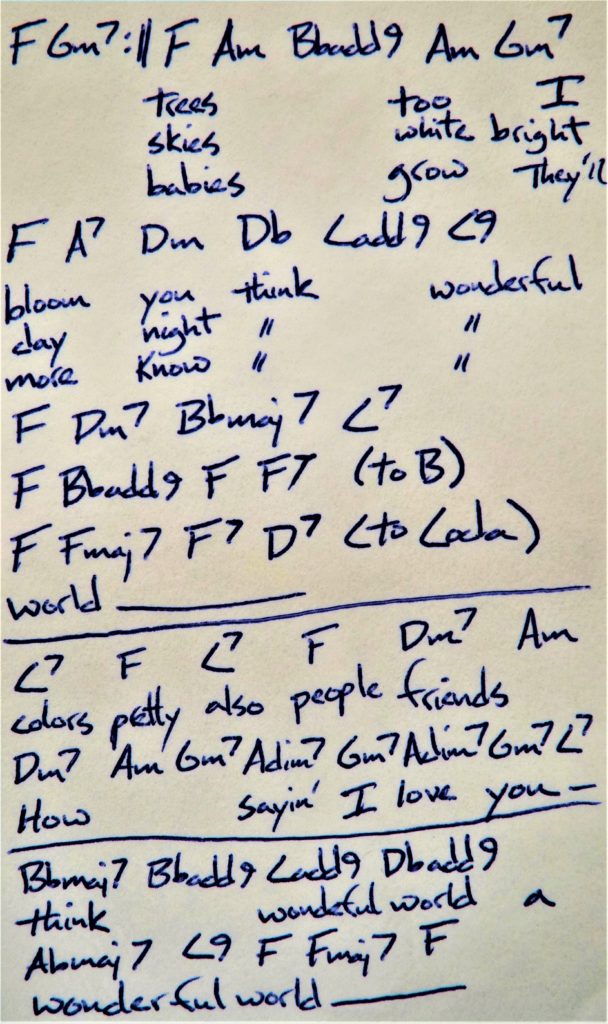
What a Wonderful World follows the classic AABA-Coda structure of many golden-age-of-Broadway musicals (aka 32-Bar Form). Each of the A-sections ends with the refrain “and I think to myself, what a wonderful world.” After the second A, you move on to the B-section (also known as the ‘middle eight’) and then go back to the A-section for the third time. Lastly you skip down to the Coda (not all AABA songs have a coda, but it is nice when they do as it helps wrap up the song). Something else that makes this song extra classy, as well as a little more difficult to memorize is that each of the A-sections has a different set of chords when you get to the last word of the refrain, ‘world.’ This really moves the song nicely and gives the audience some ear-candy.
This is probably the most difficult song I’m doing with the Happy Valley Ukes this season. I already created a sing-along to help. See http://ukuleleplay.com/what-a-wonderful-world-ukulele-sing-along/
You Are My Sunshine Ukulele Sing-along
Nicely legal copies of You Are My Sunshine sheet music may be obtained at http://bit.ly/YouaremySunshineMusic
You can also check out my personal Cue Card for You Are My Sunshine.
Singin’ in the Rain Ukulele Sing-along
Nicely legal copies of Singin’ in the Rain sheet music may be obtained at http://bit.ly/SinginintheRainMusic
You can also check out my personal Cue Card for Singin’ in the Rain.
Enjoy!
Over the Rainbow Ukulele Sing-along
Nicely legal copies of Over the Rainbow sheet music can be obtained at http://bit.ly/overtherainbowmusic
You can also check out my personal Cue Card for Over the Rainbow.
Enjoy!
Cue Cards: Over the Rainbow
My personal cue card, reduced to essentials, from the sheet music of Over the Rainbow. This is one of the songs I’m doing with Happy Valley Ukes in April 2021. You can read about cue cards here. See below the image for additional info on this cue card.
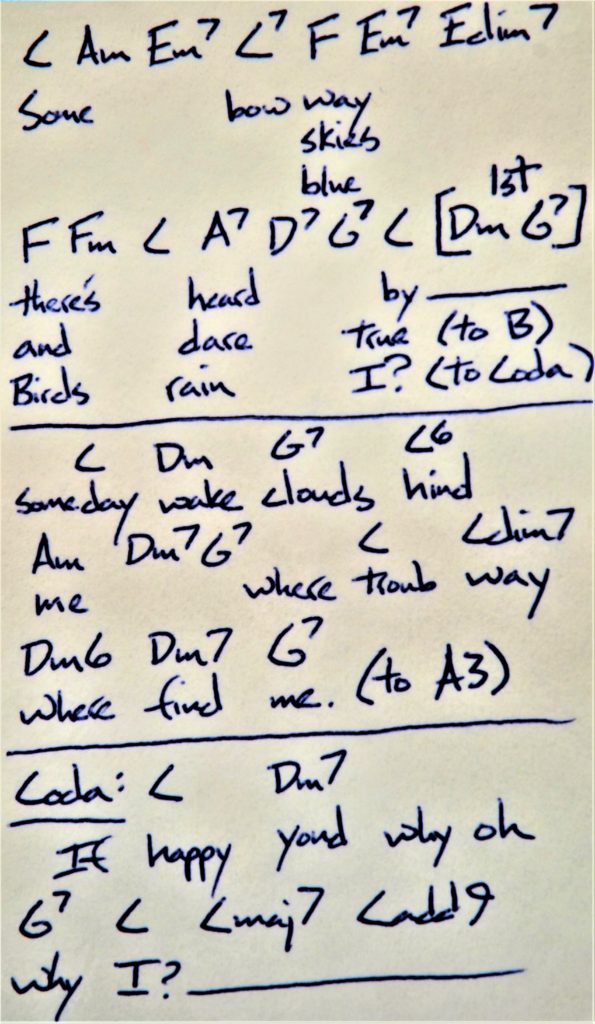
Over the Rainbow follows the classic AABA-Coda structure of many golden-age-of-Broadway musicals (aka 32-Bar Form). Each of the A-sections begins with the refrain “Somewhere over the Rainbow.” After the second A, you move on to the B-section (also known as the ‘middle eight’) and then go back to the A-section for the third time. Lastly you skip down to the Coda (not all AABA songs have a coda, but it is nice when they do as it helps wrap up the song).
See also: Over the Rainbow Ukulele Sing-along
Cue Cards: You are My Sunshine
My personal cue card, reduced to essentials, from the sheet music of You are My Sunshine. This is one of the songs I’m doing with Happy Valley Ukes ‘easy’ group in April 2021. You can read about cue cards here.
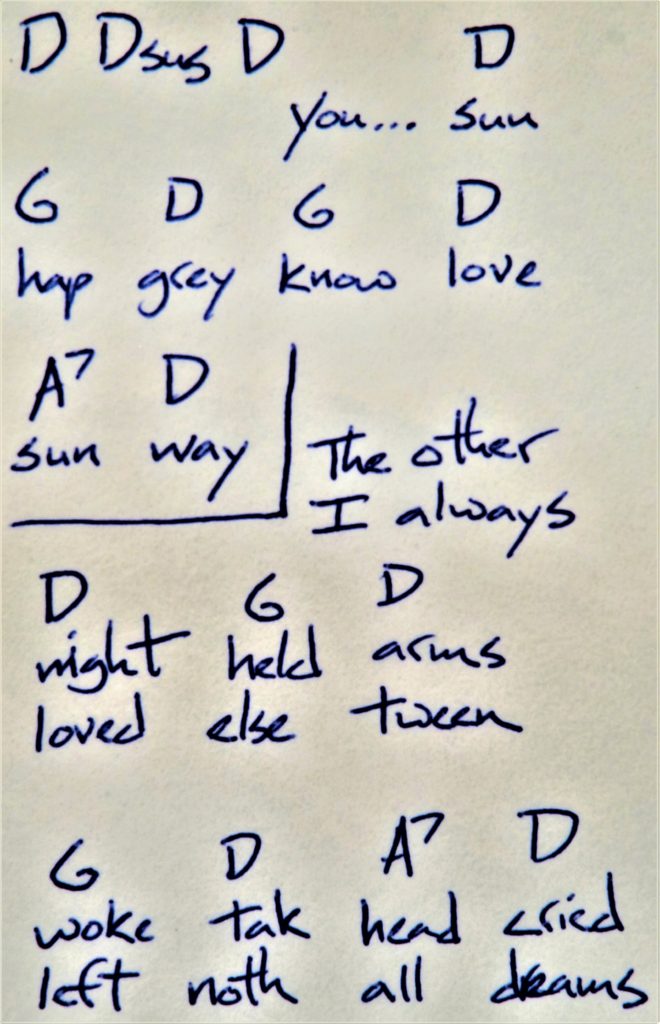
Cue Cards: Singin’ in the Rain
In my most recent article on memorization, I mentioned creating cue cards that contain the most minimal information you need to get through a song or review it … basically a list of chords with lyric ‘cues’ underneath in key places. Here is my 3×5 cue card for Singin’ in the Rain:
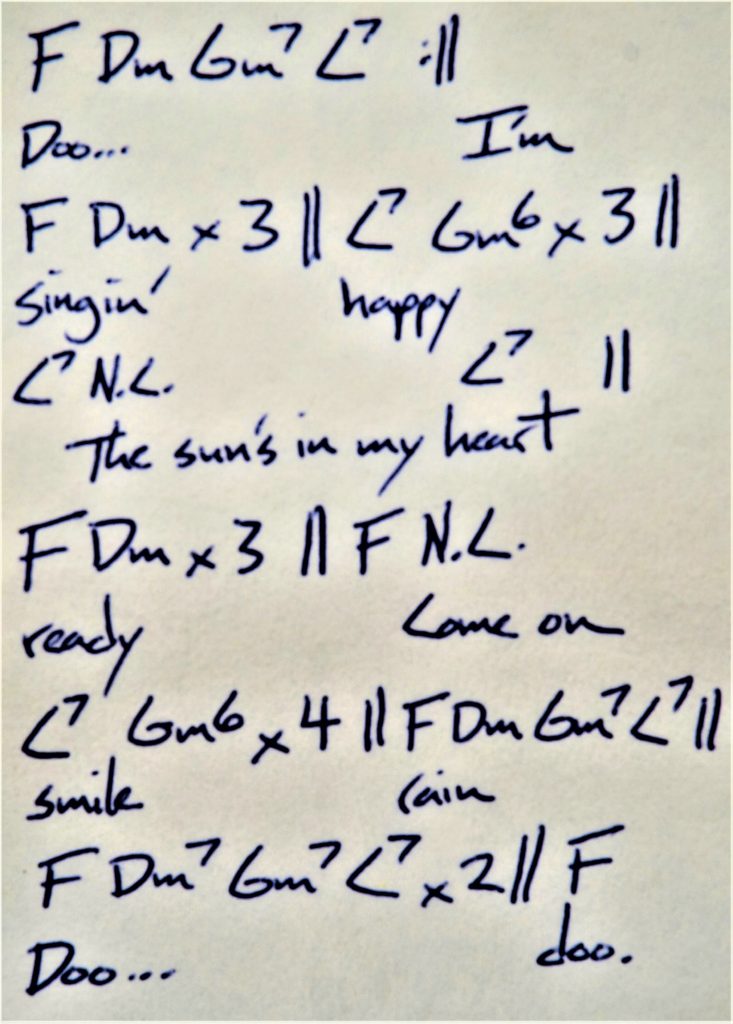
I knew this song fairly well already, so the lyric cues are extremely minimal. No one is going to learn a song from such a minimal set of chords/lyrics, however, copying the song out from the sheet music by hand is a great way to firm up the structure/patterns in your brain. By the time you’ve done that, you should be a lot farther along in your memorization.
And … if you don’t care about being completely memorized, a cue card is a great way to minimize what’s between you and you’re audience:
- Rig some way to clip the card to your mic stand.
- Make a cards on a full size sheets of paper and tape them to the floor to glance at in performance.
- Put the cards on your phone or tablet and use a mic stand clamp designed for your device.
Anyway, I’ll be posting some more of my cue cards as I make them. I have a lot of songs to memorize this Summer for performances coming up in the Fall.
See also: Singin’ in the Rain Ukulele Sing-along
Enjoy!
Memorizing Music : A Short List of Ideas
I’ve written on memorization techniques a couple of times before, but as I try things out I find that certain things work much better for me than others. This is a quick guide to the techniques I currently find most useful.
The Big Picture
- Listen to the song you want to memorize … many times. If you don’t enjoy hearing it many times, then you may want to re-think if you want to take the effort to memorize it.
- Get the sheet music in front of you and analyze it, marking it up as you go. Divide the song up into logical sections (intro, verse, chorus, bridge, aaba, coda, etc.). You’re especially looking for repeating patterns, as these will help you in the memorization process. Don’t worry about being ‘correct’ … your analysis only has to make sense to you.
- Focus your play on small sections. Once you’ve committed a section to memory you’ve got any repeats of that section (i.e. choruses) mastered, or are well on your way toward mastering similar sections (i.e. verses).
- Begin with the end in mind. Many people that have written on this subject suggest starting at the end of a song and working your way backward with the idea that once you start doing run throughs, it is like riding a bike downhill … you coast to the ending, instead of climb into less familiar territory.
- Hammer the parts of the song that only happen once. Anything that doesn’t repeat in a song is going to get less natural repetitions … so make up for it by giving it extra focus in your playing time.
- When you start run-throughs, science suggests that playing through once, going back and fixing any errors, and then letting the piece rest for a while (an hour to a day) before the next run-through … is far more effective than running through a song five, ten or twenty times in a row. You want to train your brain to know that the first time is the most important and that second times rarely come around in performance. Multiple run-throughs in a row signal the brain that it doesn’t really have to commit this info to instant recall … and brains have a lot to do, so they’re constantly looking for info to edit out and forget.
Lyric-Specific Tips
- Read the lyrics without singing them and contemplate/analyze/visualize them as if they were poetry. New meanings and understandings will often emerge that you might not have caught if you only ever sang them. A good example from my experience is Duran Duran’s View to a Kill. Sections of this song don’t make a lot of sense the way the words have been paired to the music, but when read they make complete sense.
- Memorize the lyrics as if they were a dramatic monologue, disconnected from the music … this is a great activity for the shower if you write them them on 3x5s and laminate them. Then sing them. See if there is a difference in your memory as well as the emotional depth that you deliver them with.
- Once again, divide and conquer, memorizing in sections, beginning with the end.
Tips for Chords
- Write out the chord sequences on a separate sheet of paper, or better, on 3×5 cards in sections (chorus, verse, etc.). Make sure you leave plenty of space in-between lines because we’ll be adding lyric cues later.
- Run the chords until you feel comfortable. Focus on any tricky transitions until they are smooth.
- Look for patterns as you practice your chords. Recognizing patterns always helps to reinforce memory.
- If helpful, using a numbering system (like traditional Roman numerals or the more modern and less detailed Nashville numbers) to help you see how the chords relate to each other.
- If numbers aren’t your thing, pay close attention to chord shapes as you make them and the most efficient way to transition from one shape to the next. As someone who is very spatially oriented, I think of shapes matched with fret positions much more readily than I do chord names or numbers. While this limits my ability to transpose on the fly, I see/feel/hear the flow of chord progressions almost like a dance.
- Place a lyric cue words under some chords to help orient yourself. Soon you’ll only need these cards to review your songs. Soon after, you may not even need that. That’s the goal.
Seem Like a Lot?
It is, but for some, memorization does take effort while for others, just seems to happen. You might find, depending on the complexity of the song, that you are long memorized before even getting halfway through this list of suggestions. If not, don’t worry, just keep going.
If you’re still not there by doing everything on this list, don’t worry, just go back and focus on the things that you’re having trouble with (not the easy parts you already know). Keep at it and it will come. I think memorization is achievable by anyone who is willing to put in small, focused, consistent, yet easy effort. Don’t stress, as stress is actually a brain blocker and will make the process more difficult and lengthy.
Why Bother?
Being ‘off book’ has many advantages. While it looks more professional, I wouldn’t use that as my reason. Here are some better ones:
- Feel a much deeper connection to the music. This will bring you joy.
- That joy will show, not only will it boost your mood, but it will also lead to more moving performances.
- Connect with your audience. There is something comforting about having a music stand as a shield between you and the audience; you don’t have to look them in the eye. However, if you really know a song, you can concentrate on sharing that song in love to those that listen. The chances you can send that song to their heart is so much higher.
Review is Important
Once you get a song to the point you feel it is effortless, you’ll want to start some form of ‘spaced repetition‘ program. At first you’ll review songs frequently, but as time goes on, you’ll find you can lengthen your reviews to a week, two weeks, or even a month and still get good results. This will keep that info fresh in your mind while allowing you time to add more songs to your ‘set list.’ Of course, it is always good to review songs you’re going to perform soon.
Break a Leg!
I hope you find this information useful and leads you to experiment with some or all of the above tips. I welcome hearing about your experiences, tips, advice for others, and successes. Just leave a comment below!
The Guitar in Tudor England : Book Review (i.e. why Ukulele players should care)
One word review: Wow!
Want specifics: Read on!
If you’ve been following the blog for a while, you might have seen my earlier post on the Renaissance guitar and the similarities it shares with the modern ukulele. Someone who saw the article mentioned a book by Christopher Page, The Guitar in Tudor England : A Social and Musical History.
The level of research here is mind-blowing, with scores of obscure 16th-century references to the guiterre, gittern, gitterne, etc. (Elizabethans weren’t big on standardized spelling) … the instrument we now know as the 4-course renaissance guitar, which shares many similarities to the modern ukulele. Here are some things I knew going in the book:
- Hourglass shape with flat back and sides made of bent wood (rather than carved from a block)
- Fretted with gut ties like a lute
- Gut strings
- A 4th – 3rd – 4th tuning in 4 courses (sets of strings) … gG CC EE A
Some interesting additions to this that I learned exclusively from Page’s research:
- It came in DIFFERENT SIZES! How cool is that? Today we have our Soprano/Concert/Tenor sizes, all generally tuned the same gCEA as each other, as well as the Baritone in DGBE … Queen Elizabeth was gifted a set of 3 gitterns by a prominent English instrument maker and Page speculates that these would most likely have been of two or three different sizes (one of which may have been the size of today’s soprano ukulele as evidenced by the Eglantine Table of Hardwick Hall).
- In addition to the well-documented gG CC EE A tuning (see The Renaissance Guitar 1500-1650 by James Tyler in Early Music), Page uncovered evidence that some of these Renaissance instruments may have been tuned re-entrant, without the lower octave string, like today’s ukulele.
- He also found an alternate tuning system that maintained the same 4th-3rd-4th pitch relationships, but with different specific pitches. With this information he reconstructs a 3-tiered system of tuning with specific pitches of C4 F4 A4 D5 (a 4th higher than a ukulele standard), F3 Bb3 D4 G4 (a whole-step lower than standard) and C3 F3 A3 D4 (a whole-step lower than baritone). Of course, at the time pitch was much fuzzier when it comes to specifics, but this is still cool. A modern parallel would be Sopranino, Standard and Baritone ukulele tunings.
- Lots of strong evidence that the instrument was primarily used in England to strum chords while accompanying the voice, though translations of French method books were published that showed that there was enough interest in playing it instrumentally to merit the effort.
There was sooooooo much more to this than instrument specifics though. Page explores how the instrument was popular in different layers of the social strata. The instrument belonged to:
- Henry VIII (possibly)
- Queen Elizabeth (definitely)
- Courtiers
- Spying Courtiers that used the instrument to carry a cipher
- Nobles
- Merchants
- College Men
- Taverners
- Young Wastrels
It was fascinating to read about these people, the import trade on gitterns (instruments mostly came from France), evidences in the visual record, music that was played, and many interesting appendices. Well worth the time. A great book. Five stars. *****
What a Wonderful World : Ukulele Sing-along
I created this ukulele sing-along for What a Wonderful World as a reference for my Happy Valley Ukes players … I LOVE this song, and though I don’t sing it with the gravel of Satchmo, I hope you enjoy my version anyway.
I’ve put in chord diagrams for LOTS of ‘up the neck’ inversions of chords … if you know your root position chords, go ahead and substitute; I arranged with the thought of more than one player singing and strumming together, with some on the roots and some on the inversions.
Also, I’m playing this in a very staccato jazz-like manner … if you are playing in a group it would be nice to add some people on fingerpicked arpeggios to get that 1 2 3 4 5 6 1 2 3 4 5 6 groove going that really makes this song a 12/8 rather than a 4/4 song. Using string numbers in a pattern, you would do 3 2 4 1 4 2 3 2 4 1 4 2 to get an ascending/descending arpeggio (I usually just alternate my thumb and first finger on this pattern).
Nicely legal copies of the sheet music can be purchased at http://bit.ly/wonderfulworldukulele
Why do I lead the Happy Valley Ukes?
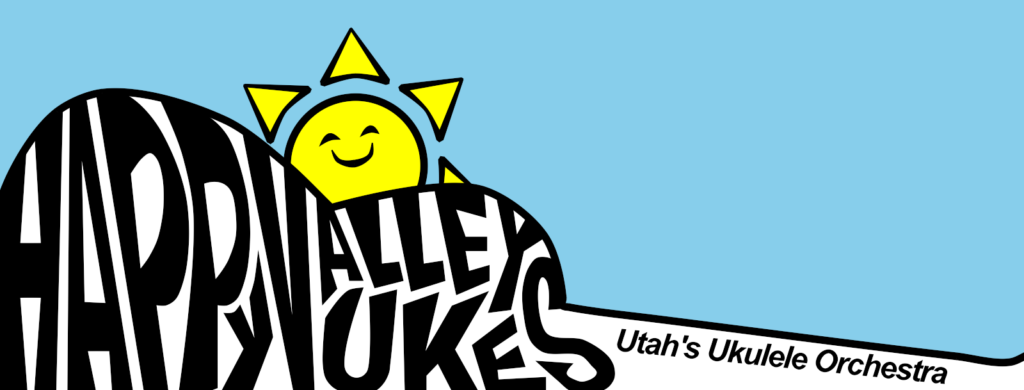
I know the past year has been hard for most everyone. While I’m actually grateful for the extra time I’ve had with my little family, whom I love to hang out with, I am at times prone to rumination and depression. Isolation really drove that side of me home. There were a lot of things this year that intensified that darker side of my personality, but I felt the greatest loss in not being able to get together and make music with people …
When I entered high school I intended to become a visual artist. Somehow, long story, I ended up taking choir and marching band instead of art. Just like that I got hooked on music, but not just any music … group music. I grew up in a musical household (my dad was a band director), but I’d never really experienced the high and the comradery that is born out of making music live with other human beings … it enhances and deepens the power of music in so many ways. When I got interested in ukulele a decade ago, I recognized it as a way to get others together making music and experiencing that joy. People who might not have had a chance to do so in the past. That is the reason for Happy Valley Ukes.
Come Join Us
- Details: https://www.patreon.com/posts/49353700
- Music for April: https://www.patreon.com/posts/49803589
Utah Live Ukulele Classes Resume April 10th
Interested in learning Ukulele in a fun group environment? or already play and want to join in with others? Happy Valley Ukes will be begin outdoor rehearsals on April 10th … Beginners at 9:30am and continuing students at 10:30am. Classes will be at the pavilion across the street from the Mt. Timpanogos Temple in Quail Cove Park (NW corner of 700 N & 900 E in American Fork) … see https://www.patreon.com/posts/49353700 for full details.
A Flea and a Fly – Uke & Me Kid (Ukulele Songs for Children)
Sheet Music
- A Flea and a Fly on Sheet Music Plus
- Also available freely to patrons at Patreon.com/Uke
Improvise for Real on Ukulele
Although this isn’t specifically a ukulele topic, I’ve had several students that were interested in improvising. I can say this is definitely not my specialty, but I came across an interesting video today that really sparked my curiosity …
My first thought was, “That was cool!” What a beautiful, simple and easy way to illustrate and start experimenting with improvising. I searched out the Improvise for Real channel and found this video that explains what is going on here with ‘Melody Paths’ …
If you find the numbers system new, a quick explanation is that in the key of C, C=1 and B=7. In the key of D, D=1 and C#=7, and so on. What I adore about the above though is taking and drawing it out so you can see the ‘melodic paths’ more easily. Fantastic.
The channel has a ton of additional free video content, including backing tracks to practice with, so check it out if you’re interested in expanding your improvisatory playing.
Lift Up Your Voice & Sing – Sing-along & Tutorial
Free Sheet Music
About
One of my favorite ‘primary’ songs for kids. My mom was the chorister who taught this to me as a child in ‘primary’ at church, so it has a special place in my heart. Most of the song is F & C7 with a few other chords in, so it is great for beginners. If you have some students, your own kids or grandkids, or want to perform for young folk, this is a great one to add to your repertoire.
Gear in this Video
Support this work at http://patreon.com/uke
Spicing up Major Chords with the Easiest Sus4 Routine for Ukulele

One of the easiest ways to ornament (i.e. spice up) your plain vanilla major chords (especially when they’re hanging out for more than a couple of beats) is to add suspended fourths.
What is a suspended fourth?
When you take the middle note of the chord (the third) and raise it half a step it becomes a ‘suspended’ fourth.
Why is it called suspended?
Because the fourth has a tendency in our ears to want to resolve back down to the third, therefore it is ‘suspended’ over the third and adds suspense an anticipation of the resolution (anticipations are however a different kind of ornament).
How can I learn which note to raise to create a suspended fourth in a major chord?
The middle note, or third, of a major chord changes position on the strings depending on which chord you’re playing on the ukulele. On C it is on string 2, but on G it is on string 1. To make things easy for me, and anyone else interested, I’ve created a chart of the ‘easiest’ sus4 fingerings for each of the 12 major chords. You can download it right here:
What are some ideas for using this?
You will notice that I did NOT use all the ‘root position’ chords in this chart. For some chords, making the transition between major and sus4 is much easier further up the neck. You’ll also notice that some of the barre chords repeat the same patterns (Bb & B as well as Db, D, Eb, E, F# & Ab); this means that there are less patterns to memorize than you might think.
- Play through all the chords.
- Play the idiomatic Major to sus4 back to Major that you find in a lot of songs.
- Pull out some songs you know and throw in some sus4 chords on major chords that hang around for 3 or more beats. Sometimes it will work fantastic and others it won’t. Experiment.
- Use a pencil to mark the instances of sus4 that really add to the emotion of the piece. It can be overdone and lose its effect, so be careful.
Happy sussing!
Great Performances: Top of the World – Carpenters Cover by Rio
This really took me on a trip back to my youth. I remember playing this album over and over … on 8-track tape!
